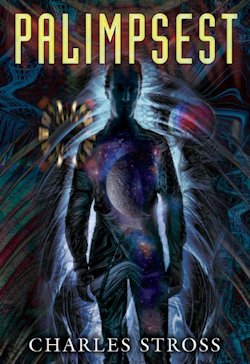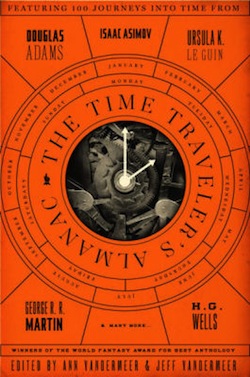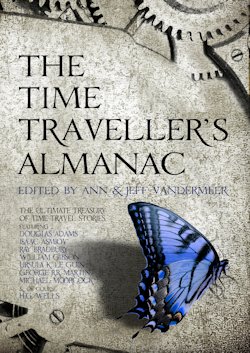Welcome back to the Short Fiction Spotlight, a weekly column dedicated to doing exactly what it says in the header: shining a light on the some of the best and most relevant fiction of the aforementioned form.
We’ve been doing this for nearly a year, you know. A year, it seems to me, of extraordinary anthologies, like The Lowest Heaven, Fearsome Journeys, Shadows of the New Sun, Unnatural Creatures, Unfettered and The Book of the Dead. There are more to come, of course—not least End of the Road in early December—but as awesome as all these have been, in terms of ambition, The Time Traveller’s Almanac has them all beat. Beat to say the least.
It’s a behemoth of a book, in truth, at almost 1000 plus-sized pages. Reading it on and off over the past couple of weeks, I’ve found that you can’t hold it like you would a normal novel; this is an anthology so immense that you have to embrace it, basically.
Its sheer substance is, in short, stunning. But before I’m accused of confusing quantity for quality, look at this incredible list of contributors: Ursula K. Le Guin, Michael Moorcock, Connie Willis, Kage Baker, Douglas Adams, Isaac Asimov, Carrie Vaughn, William Gibson, Robert Silverberg, Ray Bradbury, Harry Turtledove, Theodore Sturgeon, George R. R. Martin, Kim Newman, Greg Egan, Elizabeth Bear, Joe Lansdale, Gene Wolfe, Peter Crowther, Karin Tidbeck, Greg Egan, Adrian Tchaikovsky, Adam Roberts, Kristine Kathyrn Rusch, and—of course, as it says on the lovely cover—the grandfather figure of time travel: H. G. Wells himself.
Know, furthermore, that this list represents a fraction—far less than half—of all the authors whose work editors extraordinaire Ann and Jeff VanderMeer have seen fit to reprint in The Time Traveller’s Almanac. Truly, this is one science fiction compendium to rule them all, and it begins, as we will, with one of the first modern time travel narratives of note: published in Amazing Stories in 1953, when the form was evidently taking the genre by storm, “Death Ship” by the late, great Richard Matheson describes the plight of a party of astronauts whose mission it is to chart the galaxy.
Whilst flying over one particular planet, they see something strange:
Mason kept his unblinking gaze on the viewer, watching the earth below move past like a slowly rolled tapestry of woods and fields and rivers. He was thinking, in spite of himself, that maybe the moment had arrived at last. The moment in which Earthmen would come upon life beyond Earth, a race evolved from other cells and other muds. It was an exciting though. 1997 might be the year. And he and Ross and Carter might now be riding a new Santa Maria of discovery, a silvery, bulleted galleon of space.
1997! The good old days, eh?
In any case, the astronauts carefully land their craft, and set about seeking out the source of the flashing that had attracted them: the reflective wreckage of a ship.
Or what was left of a ship for, apparently, it had struck the earth at terrible velocity, nose first. The main structure had driven itself about fifteen feet into the hard ground. Jagged pieces of superstructure had been ripped off by the crash and were lying strewn over the field. The heavy engines had been torn loose and nearly crushed the cabin. Everything was deathly silent, and the wreckage was so complete they could hardly make out what type of ship it was.
The sight of this smashed ship is both thrilling and chilling, for us as much as Matheson’s characters, who can hardly imagine what revelations await. Thus, they investigate the cabin. And in the corner… corpses.
But here’s what makes this story particularly magnificent: “The twisted bodies on the floor were theirs, all three of them. And all three… dead.”
Are they future versions of themselves, or something else?
Shocked and appalled, our astronauts proceed to bicker like children in an attempt to figure out what in God’s name is going on. They realise that they can’t stay on the planet for long—they’ll freeze to death within a few weeks if they don’t run out of food first—but if they leave, they risk having the crash that appears to have led to their deaths.
Though the characters aren’t developed in any depth, “Death Ship” is a terrific old-timey time travel narrative. The puzzling paradox it revolves around is a pleasure, the banter great, if dated, and the plot races along like a rocket.
The whole story, however, seemed… suspiciously familiar. In short order, it dawned on me that I had heard it—and indeed seen it—before, because an episode of one of my favourite TV series of all time was based on it. I’m talking about The Twilight Zone, of course. Nevertheless, the last minute twist that helps make Matheson’s narrative is every bit as unsettling in this original iteration of the tale as it was in Rod Serling’s classic audiovisual anthology.

According to the arrangement of the short stories brought together in The Time Traveller’s Almanac, “Death Ship” is an experiment, whereas “Palimpsest” by Charles Stross, which closes out this splendid collection, is more of a communiqué from the future—though its protagonist, Pierce, is plucked from the present to be an Agent of the Stasis: a clandestine civil service of sorts, which since the discovery of time travel has, in addition to “reseeding” humanity on every occasion extinction looks likely, policed each discrete period of the planet. That said:
The Stasis were spread surprisingly thin across their multitrillion-year empire. The defining characteristic of [Pierce’s] job seemed to be that he was only called in for turbulent, interesting times. Between peak oil and Spanish flu, from Carthage to the Cold War, his three-thousand-year beat sometime seemed no more than a vale of tears—and a thin, poor, nightmare of a world at that, far from the mannered, drowsy contentment of the ten-thousand-year-long Hegemony.
“Palimpsest” primarily chronicles the twenty years Pierce spends in training before he’s declared a fully-fledged Agent. Twenty years during which he meets the loves of his life, twice, has a new heart implanted, and comes to understand just how unstable history is. All the while, someone seems set on assassinating him. But why, he wonders. What has he done?
More perceptive, perhaps, to wonder what he will do.
Much has been said about this Hugo Award-winning novella in the years since its initial publication as part Charles Stross’ second collection, but for all that it’s been talked about, this was the first time I’d read “Palimpsest.” Now I know why there was such a fuss, and why Subterranean Press saw fit to reprint it in a lovely (alas long since sold out) limited edition.
I was, quite frankly, floored by Stross’ story. Beyond the paltry synopsis I put together in the previous paragraphs, there’s so much going on that the mind positively boggles. There’s the romance, of course; there’s hard science, albeit hard science of the sort that interested me as opposed to intimidating my tiny mind; and it’s a proper page-turner, too, in terms of the repeated attempts on Pierce’s person.
It comes as no surprise that Stross has said “Palimpsest” may one day form the foundation of a proper novel. If I could travel in time to the day that happens, I’d have a hard time resisting… however a large part of what works so well herein “Palimpsest” is its density, the mad abandon with which the author approaches the engrossing concepts underpinning it. Give me more in this milieu—oh, go on!—but its specific narrative and characters need no expanding. Stross’ long short is pretty much perfect as is.
“Palimpsest” demonstrates a markedly different take on time travel than “Death Ship” does, but for all that they could hardly be farther apart, taken together they stand to describe the depth and breadth and potential complexity of all the science fiction on offer in this massive and massively elaborate new anthology.
The Time Traveller’s Almanac will be released later this week by Head of Zeus in Great Britain and beyond. If you’re based in the United States, I’m afraid you may have to hold out till Tor publish the North American edition in the Spring, but be sure: it’s well worth the wait.
How about we do this over again then?
Niall Alexander is an extra-curricular English teacher who reads and writes about all things weird and wonderful for The Speculative Scotsman, Strange Horizons, and Tor.com. He’s been known to tweet, twoo.











